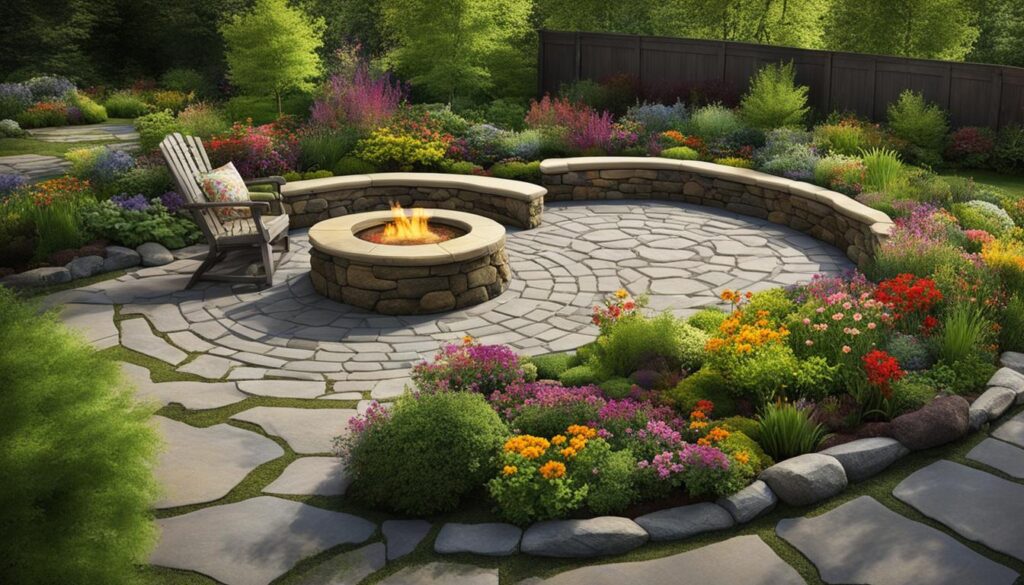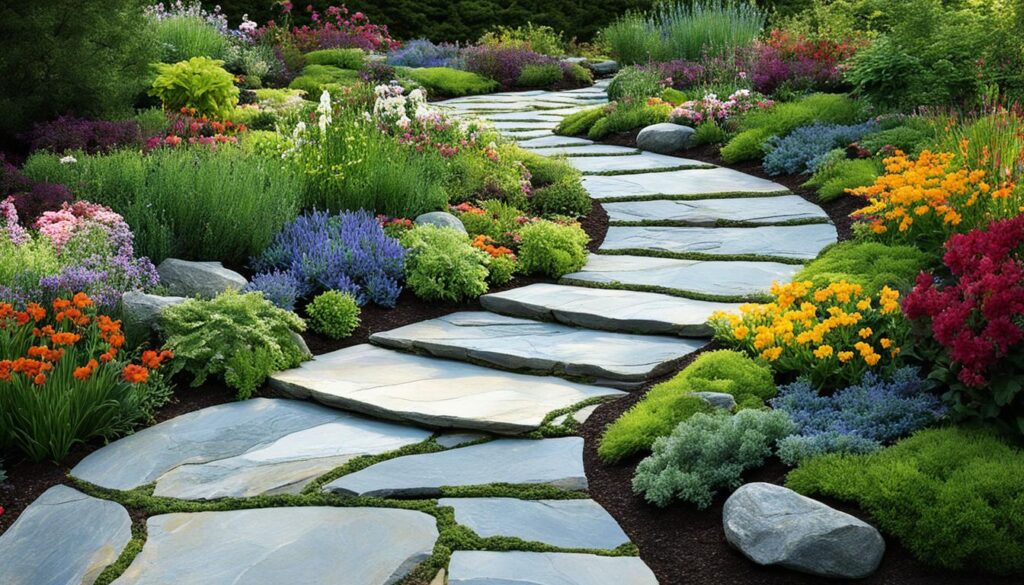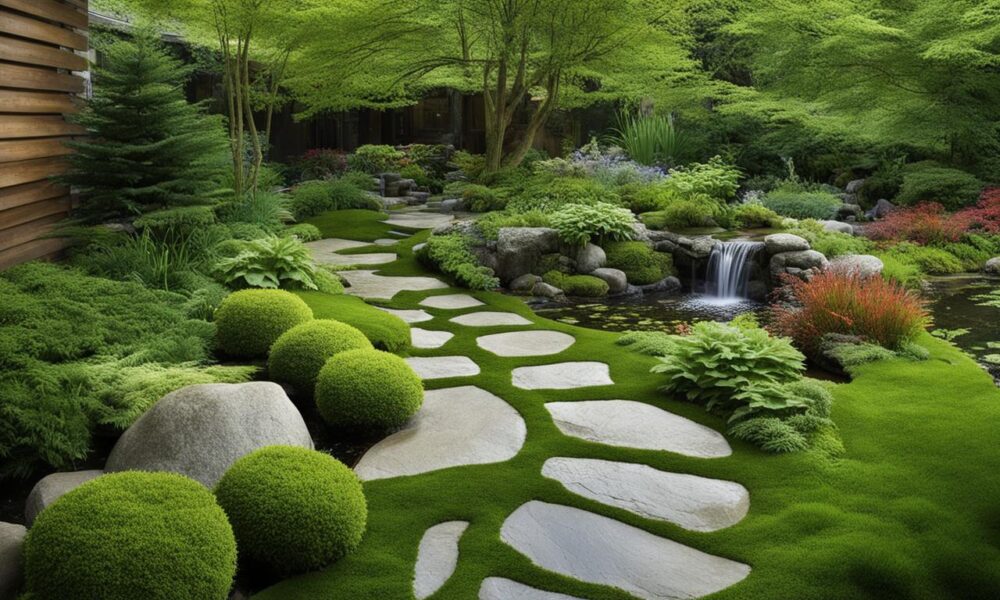Creative Natural Stone Edging Ideas for Gardens
Natural stone edging can elevate the beauty of your garden, providing a touch of elegance and structure to your outdoor space. By incorporating natural stone into your landscaping, you can create a crisp and clean design that enhances the overall aesthetic. Whether you prefer a rustic brick border or a classic flagstone outline, there are numerous creative ideas to explore. From DIY projects to cost-effective options, natural stone edging offers endless possibilities for transforming your garden.
Key Takeaways:
- Natural stone edging adds character and texture to your garden, creating a visually appealing design.
- Brick and flagstone are popular options for natural stone edging, each offering a unique look.
- Mixing and matching rock shapes and colors can create a natural and artistic effect.
- Low-growing plants and decorative grasses complement natural stone edging.
- Proper installation and regular maintenance ensure the longevity and beauty of your natural stone edging.
Best Plants for Natural Stone Edging
When it comes to natural stone edging, choosing the right plants can enhance the overall aesthetic and add a touch of charm to your landscaping. Low-growing and draping plants are perfect for softening hard edges and creating a harmonious blend with the stone. Here are some of the best plants to consider:
- Sweet Alyssum – These delicate, fragrant flowers are ideal for creating a beautiful border. They come in various colors, such as white, pink, and purple, adding a pop of vibrancy to your garden.
- Veronica – With its upright flower spikes, the Veronica plant complements the natural stone edging, adding an elegant touch to your landscape. Choose from different varieties like creeping or upright for varying heights and textures.
- Bouncing Bet – Also known as Soapwort, this low-maintenance perennial produces pretty pink or white flowers that spill gracefully over the stone edging, creating a soft and inviting look.
- Artemisia – The feathery gray foliage of Artemisia contrasts beautifully against the stone and adds an element of texture to your garden. It’s an excellent choice for a classic, timeless look.
- Coralbells – Coralbells, also called Heuchera, offer a range of colorful foliage, from deep burgundy to lime green. The foliage creates a stunning visual contrast against the natural stone, especially when planted in clusters.
- Candytuft – Candytuft is a low-growing, evergreen plant that produces clusters of white flowers. It spreads quickly and can create a beautiful white border, enhancing the crispness of the stone edging.
If you prefer a more manicured look, consider planting a straight line of decorative grasses or evergreen shrubs along the edge of your natural stone. These plants provide structure and add a formal touch to your landscaping. Choose from popular options like fountain grass, boxwoods, or dwarf mondo grass.
Insider Tip:
“Don’t be afraid to mix and match different plants and experiment with colors and textures. The key is to find a combination that complements your natural stone edging and reflects your personal style.”
By carefully selecting the right plants, you can enhance the beauty of your natural stone edging and create a harmonious and inviting outdoor space.
| Plant | Height | Flower Color | Foliage Color | Hardiness Zone |
|---|---|---|---|---|
| Sweet Alyssum | 6-8 inches | White, Pink, Purple | Green | 3-9 |
| Veronica | 6-30 inches | Blue, Pink, White | Green | 3-9 |
| Bouncing Bet | 8-24 inches | Pink, White | Green | 3-10 |
| Artemisia | 6-48 inches | N/A | Gray | 3-9 |
| Coralbells | 6-30 inches | N/A | Various Colors | 4-8 |
| Candytuft | 6-12 inches | White | Green | 3-9 |
How to Install Natural Stone Edging
Installing natural stone edging is a straightforward process that can add a touch of elegance to your garden. Whether you’re opting for brick, flagstone, or rocks, proper installation is key to achieving a durable and visually appealing result.
Brick Edging
For brick edging, start by tightly pushing the bricks together in a bed of sand. This will minimize spaces and prevent heaving. Make sure the bricks are level and aligned for a clean and polished look. The sand base provides stability and allows for slight adjustments when positioning the bricks.
Flagstone Edging
When installing flagstone edging, begin by digging a trench along the desired edge. This trench should be slightly wider and deeper than the flagstones. Add sand to the bottom of the trench to allow for proper drainage. Carefully stack the flagstones, ensuring they are securely in place. Take your time to find the right fit and adjust the stones as needed. Once installed, the flagstones will create a beautiful and natural-looking border.
Rock Edging
For a more rustic and organic look, consider using rocks to create edging. Position the rocks in a winding pattern, allowing for a natural flow. Leave enough space between the rocks for plants to grow and intertwine, creating a lacy and scalloped effect. This style of edging works particularly well in cottage gardens or naturalistic landscapes.
“Proper installation is key to achieving a durable and visually appealing natural stone edging.”
By following these installation techniques, you can transform your garden with the timeless beauty of natural stone edging. Whether you choose brick, flagstone, or rocks, the result will be a stunning addition to your outdoor space.
Cost-Effective Natural Stone Edging Options
Creating natural stone edging doesn’t need to break the bank. With some innovative ideas and cost-effective materials, you can achieve a beautiful and budget-friendly border for your garden. Here are a few options to consider:
1. Mismatched Bricks on the Diagonal
Give your garden a charming 19th-century domino effect by using mismatched bricks on the diagonal. This technique adds a unique touch to your natural stone edging while utilizing affordable materials. Simply arrange the bricks diagonally, gradually forming a cohesive pattern that adds character to your garden.
2. Brick Edge with Cheap Sand
Another budget-friendly option is to create a brick edge by setting bricks in a trench and leveling them with inexpensive sand. This simple yet effective method provides a clean and defined edge for your garden. Plus, it allows for easy maintenance and replacement of individual bricks if needed.
3. Gray Gravel Border
If you’re looking for a decorative and inexpensive option, consider a gray gravel border. Not only does it act as a barrier to discourage people from walking on the lawn, but it also adds visual appeal to your garden. This cost-effective solution creates an attractive contrast against the surrounding greenery.
4. Budget Brick Edge with Cheap Sand
Create a budget-friendly brick edge by digging a trench and setting bricks in low-cost sand. This method offers a classic and timeless look for your natural stone edging, blending seamlessly with various garden styles. The affordability of this option makes it accessible to DIY enthusiasts looking to enhance their outdoor spaces.
By exploring these cost-effective natural stone edging options, you can transform your garden without breaking the bank. Choose the method that best suits your style, budget, and the overall aesthetic you envision for your outdoor space.
Landscaping with Natural Stone Edging
When it comes to transforming your outdoor space, natural stone edging can play a crucial role in creating beautiful and functional landscaping designs. By incorporating this versatile element, you can define and separate different areas, such as flower beds, vegetable gardens, and walkways, adding structure and aesthetic appeal to your garden.
With a wide variety of natural stones to choose from, including brick, flagstone, and rocks, you can experiment with different patterns, layouts, and combinations to create a unique and personalized landscaping design. Whether you prefer a traditional or contemporary style, natural stone edging offers endless possibilities for enhancing the overall look and feel of your outdoor space.
One of the key advantages of landscaping with natural stone edging is its ability to provide distinct borders. By clearly defining the boundaries between different areas, you can create a well-organized and cohesive garden layout. This not only adds visual appeal but also helps to prevent grass or unwanted plants from encroaching on your flower beds or walkways.
Furthermore, natural stone edging blends functionality with visual appeal. It not only helps to keep your garden organized but also makes maintenance tasks more manageable. With a defined edge, mowing and trimming become easier, allowing you to maintain a neat and tidy appearance effortlessly.
Are you looking for inspiration to get started with your natural stone edging project? Consider the following ideas:
- Create a rustic and charming garden pathway using irregularly shaped flagstones, bordered by a combination of colorful plants.
- Outline your flower beds with brick edging for a classic and timeless look.
- Experiment with different rock sizes and colors to create a natural and textured border for your vegetable garden.
- Design a contemporary landscape using sleek and uniform granite or limestone slabs for clean and visually stunning edging.
Remember, the design possibilities are endless, and you can customize your landscaping to suit your personal style and preferences.
| Benefits of Landscaping with Natural Stone Edging | Tips for Successful Landscaping with Natural Stone Edging |
|---|---|
| 1. Adds structure and definition to your garden | 1. Plan your edging layout and design before installation |
| 2. Enhances the overall aesthetic appeal of your outdoor space | 2. Prepare the ground properly by removing grass or weeds |
| 3. Prevents grass and unwanted plants from invading flower beds or walkways | 3. Use a level to ensure a straight and even edging installation |
| 4. Makes maintenance tasks, such as mowing and trimming, easier | 4. Consider using landscaping fabric beneath the edging for better weed control |
| 5. Provides a durable and long-lasting solution for your landscaping needs | 5. Add a layer of mulch or gravel for a polished and finished look |
By incorporating natural stone edging into your landscaping, you can create a visually stunning and well-organized outdoor space. Let your creativity flow and experiment with different types of natural stone, patterns, and layouts to design a landscape that reflects your personal style.

Next, we’ll explore some exciting DIY natural stone edging projects that you can easily tackle to further enhance your garden’s beauty and showcase your creativity.
DIY Natural Stone Edging Projects
If you’re a DIY enthusiast, there are plenty of natural stone edging projects you can tackle. With a little creativity and some basic materials, you can add a unique touch to your garden. Here are a few ideas to get you started:
1. Stone Flower Bed Border: Source field stones from local stone places and create a stunning stone border for your flower beds. You can arrange the stones in various shapes and sizes to create a charming and rustic look. This project is perfect for adding a touch of Instagram-worthy beauty to your garden.
2. Simple Stone Border: Create a simple yet elegant stone border in your backyard using rocks or boulders. Dig a shallow trench along the edge of your garden bed and place the stones securely in the ground. This DIY project adds a natural and visually appealing boundary to your outdoor space.
3. Wood with Natural Stone Edging: Consider using wood to create raised beds with natural stone edging. Build the raised beds using wood boards and secure natural stone edging along the outer edges. This combination of materials adds a charming and rustic touch to your garden while providing functional raised beds for planting.
DIY projects allow you to customize your garden and showcase your creativity. Get inspired by these ideas and let your imagination run wild!
Creative Natural Stone Edging Designs for Garden Paths
Enhance the beauty of your garden paths with creative natural stone edging designs. By incorporating different stones, colors, and textures, you can create visually stunning and functional pathways that elevate the overall aesthetic of your outdoor space.
Choosing the Right Stones
When selecting stones for your garden paths, consider the overall theme and style you want to achieve. You can mix and match different types of natural stones, such as limestone, granite, or slate, to add depth and visual interest to your pathway.
For a cohesive look, choose stones that complement the surrounding landscape and existing hardscaping elements. You can also experiment with various sizes and shapes to create unique patterns and designs.
Design Ideas
Here are some creative natural stone edging designs for garden paths:
- Stepping Stone Pathway: Use large flat stones as stepping stones, surrounded by smaller rocks or pebbles to create a natural and inviting pathway.
- Mosaic Pathway: Arrange different colored stones in intricate patterns to create a mosaic effect that adds a touch of artistry and visual appeal to your garden.
- Curved Edging: Create a curved path with natural stone edging to add a sense of flow and elegance to your garden. This design works particularly well in lush, organic landscapes.
- Contrasting Borders: Combine light-colored stones with dark-colored stones to create contrasting borders that draw attention to the pathway and highlight its unique design.
With these creative designs, you can transform your garden paths into captivating features that seamlessly blend with the surrounding vegetation and create a harmonious outdoor environment.
Maintenance Tips
To keep your natural stone edging looking its best, regular maintenance is essential. Remove any debris or weeds that may accumulate between the stones, and ensure proper drainage to prevent water accumulation that can damage the pathway.
Occasionally clean the stones with water and a mild detergent to remove dirt or stains. Additionally, inspect the edging for any signs of damage and repair or replace any stones as needed to maintain the integrity and visual appeal of your garden paths.

Investing time and effort in designing and maintaining your natural stone edging will result in beautiful, functional garden paths that add value and beauty to your outdoor space. The possibilities are endless, so unleash your creativity and explore the world of natural stone edging designs for garden paths.
The Benefits of Natural Stone Edging
Natural stone edging offers several benefits for your garden and landscaping. It provides a range of advantages that can enhance the overall appeal and functionality of your outdoor space. Whether you’re looking to define different areas, add visual interest, or simplify maintenance tasks, natural stone edging is a versatile option to consider.
1. Define and Separate Areas
Natural stone edging helps create distinct boundaries, allowing you to define and separate different areas in your garden. Whether it’s flower beds, walkways, or outdoor seating areas, the edging provides a clear distinction between various elements, preventing the grass from encroaching on your desired spaces. This not only adds structure to your landscaping but also helps maintain the overall organization and order of your garden.
2. Enhance Visual Appeal
The use of natural stone edging adds charm and visual interest to your garden. The natural textures, colors, and patterns of the stones create a unique and elegant look that complements your landscaping design. Whether you opt for rustic brick, classic flagstone, or creatively arranged rocks, natural stone edging adds a touch of beauty and sophistication to your outdoor space, making it visually appealing and inviting.
3. Ease of Maintenance
One of the practical benefits of natural stone edging is how it simplifies maintenance tasks. By providing a defined edge, it makes mowing and trimming the lawn much easier. You can easily maneuver your lawnmower along the edges without worrying about damaging your plants or going over the boundaries. Additionally, natural stone edging helps keep mulch, soil, and other materials in place, reducing the need for frequent cleanups and ensuring a tidy and well-maintained garden.
4. Durability and Longevity
Natural stone is a durable and long-lasting material that can withstand outdoor elements. Unlike plastic or metal edging options, natural stone is resistant to fading, warping, or deteriorating over time. It can withstand temperature changes, heavy rainfall, and other weather conditions, ensuring that your garden edging remains intact and visually appealing for years to come. The durability of natural stone also makes it a cost-effective option, as you won’t need to replace or repair it frequently.
Tips for Maintaining Natural Stone Edging
To keep your natural stone edging looking its best, regular maintenance is required. By following these simple tips, you can ensure the longevity and aesthetic appeal of your natural stone edging.
1. Remove Debris, Weeds, and Grass
Regularly remove any debris, weeds, or grass that may accumulate along the edges of your natural stone edging. This will help maintain a clean and neat appearance, preventing any unwanted growth from overshadowing the beauty of the stone.
2. Clean with Mild Detergent
Periodically clean the natural stone with water and a mild detergent to remove dirt or stains. Gently scrub the surface of the stone using a soft brush or sponge to avoid causing damage. Rinse thoroughly with water to ensure all detergent residue is removed.
3. Inspect for Damage
Regularly inspect your natural stone edging for any signs of damage, such as cracks, chips, or loose stones. Repair or replace any damaged stones promptly to maintain the integrity and overall appearance of the edging.
4. Apply Sealer
Consider applying a stone sealer to protect the natural stone and enhance its longevity. A sealer can help prevent staining and deterioration caused by weather and other environmental factors. Follow the manufacturer’s instructions for proper application and reapplication of the sealer.
5. Take Precautions
Take precautions to prevent damage to your natural stone edging. Avoid using harsh chemicals or abrasive materials that can scratch or discolor the surface of the stone. Be mindful when performing other landscaping tasks, such as mowing or trimming, to avoid accidentally damaging the edging.
Maintaining natural stone edging is crucial to preserve its beauty. Regular cleaning, inspection, and preventative measures help ensure longevity and aesthetic appeal.
The Impact of Natural Stone Edging on Landscaping
Natural stone edging can have a significant impact on your overall landscaping. When incorporated thoughtfully, it adds structure, definition, and cohesion to your outdoor space, creating a polished and professional look.
The right choice of natural stone edging can complement your existing landscaping elements, such as plants, trees, and hardscaping features. By carefully selecting stones that harmonize with the surrounding environment, you can create a seamless transition between different elements in your garden.
Not only does natural stone edging enhance the aesthetics of your landscaping, but it also improves its functionality. By clearly defining different areas and pathways, it helps guide the flow of movement in your garden. Whether it’s demarcating flower beds, outlining walkways, or separating various garden zones, natural stone edging provides clarity and order.
Furthermore, natural stone edging can also serve as a practical solution to prevent erosion and maintain the integrity of your garden. It acts as a barrier that retains soil, preventing it from being washed away during heavy rainfall or watering. This helps keep your garden neat and organized, minimizing maintenance efforts.
Whether you have a small backyard or a sprawling garden, natural stone edging can transform the look and feel of your outdoor space. Its impact goes beyond mere beauty, fostering a sense of harmony and balance in your landscaping design.
Enhancing Landscaping with Natural Stone Edging
When it comes to incorporating natural stone edging into your landscaping, there are several ways to achieve stunning results. Here are a few tips to inspire your next project:
- Create a border using a mix of different natural stone types, sizes, and colors to add visual interest.
- Consider using natural stone edging to highlight specific areas or focal points in your garden, such as a water feature or sculpture.
- Experiment with different edging patterns and designs, such as staggered rows or a gentle curve, to create a unique and personalized look.
- Combine natural stone edging with complementary plants and flowers to create a cohesive and harmonious landscape.
By exploring these creative options and tailoring them to your unique preferences, you can elevate your landscaping to new heights.
| Benefits of Natural Stone Edging | Enhancements to Landscaping | Overall Impact |
|---|---|---|
| Clear definition of garden areas | Guidance for movement and flow | Polished and professional look |
| Erosion prevention | Highlighting focal points | Enhanced aesthetics |
| Maintain soil integrity | Customizable patterns and designs | Functional and practical solution |
| Easy maintenance | Complementary integration with plants | Harmony and balance in design |
As illustrated in the table above, the impact of natural stone edging on landscaping is multifaceted. It brings numerous benefits, enhances different aspects of your garden, and contributes to the overall appeal of your outdoor space.
Landscaping Inspiration with Natural Stone Edging
Natural stone edging provides endless possibilities for landscaping inspiration. Whether you’re looking to add charm to your flower beds or create stunning garden paths, the use of natural stone can elevate the aesthetics of your outdoor space. To gather ideas and inspiration for your own landscaping projects, social media platforms like Instagram are a treasure trove of creativity.
Follow these popular accounts for landscaping inspiration:
- The Psychiatrist’s Garden
- Addicted 2 Decorating
These accounts feature stunning natural stone edging designs, unique combinations of plants and stones, and invaluable tips for creating beautiful outdoor spaces. From traditional brick patterns to intricate flagstone arrangements, you’ll find a wealth of ideas to inspire your own natural stone edging endeavors.
Take a moment to browse through the captivating images shared by these creative minds and let your imagination run wild. You’ll soon find yourself envisioning the perfect natural stone edging for your garden, transforming it into a true masterpiece of landscaping art.
Finding Inspiration in Beautiful Landscapes
Great landscaping inspiration can also be found beyond the digital realm. Take a walk through your neighborhood or visit local botanical gardens to observe how natural stone edging is implemented in various settings. You’ll discover remarkable design ideas and unique ways to incorporate natural stones into your own garden.
“Landscaping is an art that allows you to express your creativity and personal style. Natural stone edging adds that extra touch of elegance and sophistication to any landscape, making it truly special.”
To create a visually appealing and cohesive landscape, consider the overall theme and aesthetics of your outdoor space. Whether you opt for a formal or informal style, natural stone edging can be tailored to suit your preferences. What better way to enhance your garden’s appeal than by adding a touch of natural beauty and charm?
| Benefits of Landscaping with Natural Stone Edging: |
|---|
| Creates defined borders and separates different areas |
| Enhances the overall appearance of your garden |
| Facilitates maintenance tasks like mowing and trimming |
| Offers durability and long-lasting beauty |
With the extensive range of natural stone options available, the only limit to your landscaping inspiration is your imagination. So, let your creativity bloom and explore the wondrous possibilities of natural stone edging in your garden!
Conclusion
Natural stone edging offers a wide range of creative possibilities for enhancing your garden. With various options available, such as brick, flagstone, rocks, and more, you can create unique and visually appealing designs. Whether you’re looking for cost-effective options, DIY projects, or inspiration for landscaping with natural stone edging, there are plenty of resources and ideas to explore.
By incorporating natural stone edging into your garden, you can transform your outdoor space and create a stunning and lasting landscape. The use of natural stone edging not only adds character and texture to your garden but also helps define and separate different areas, preventing the grass from encroaching on flower beds or walkways. It adds structure, definition, and cohesion to your outdoor space, creating a polished and professional look.
Whether you’re a DIY enthusiast or prefer to hire a professional landscaper, natural stone edging is a versatile option that blends functionality with visual appeal. Explore different natural stone edging ideas, experiment with various patterns and layouts, and let your creativity shine. With natural stone edging, you can add that finishing touch to your garden and make it a beautiful and inviting oasis.



